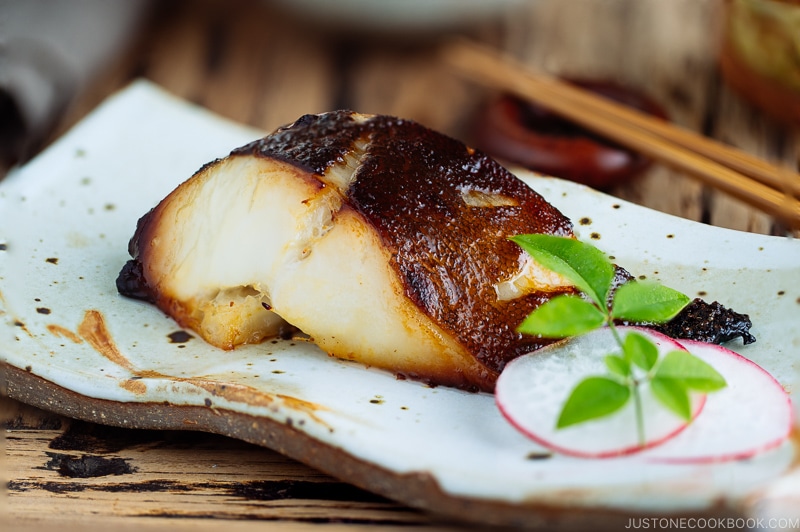
Miso Cod is an exquisite Japanese seafood recipe of succulent and buttery black cod that simply melts in your mouth! With just a handful of ingredients, you can recreate this restaurant-quality delicacy at home.
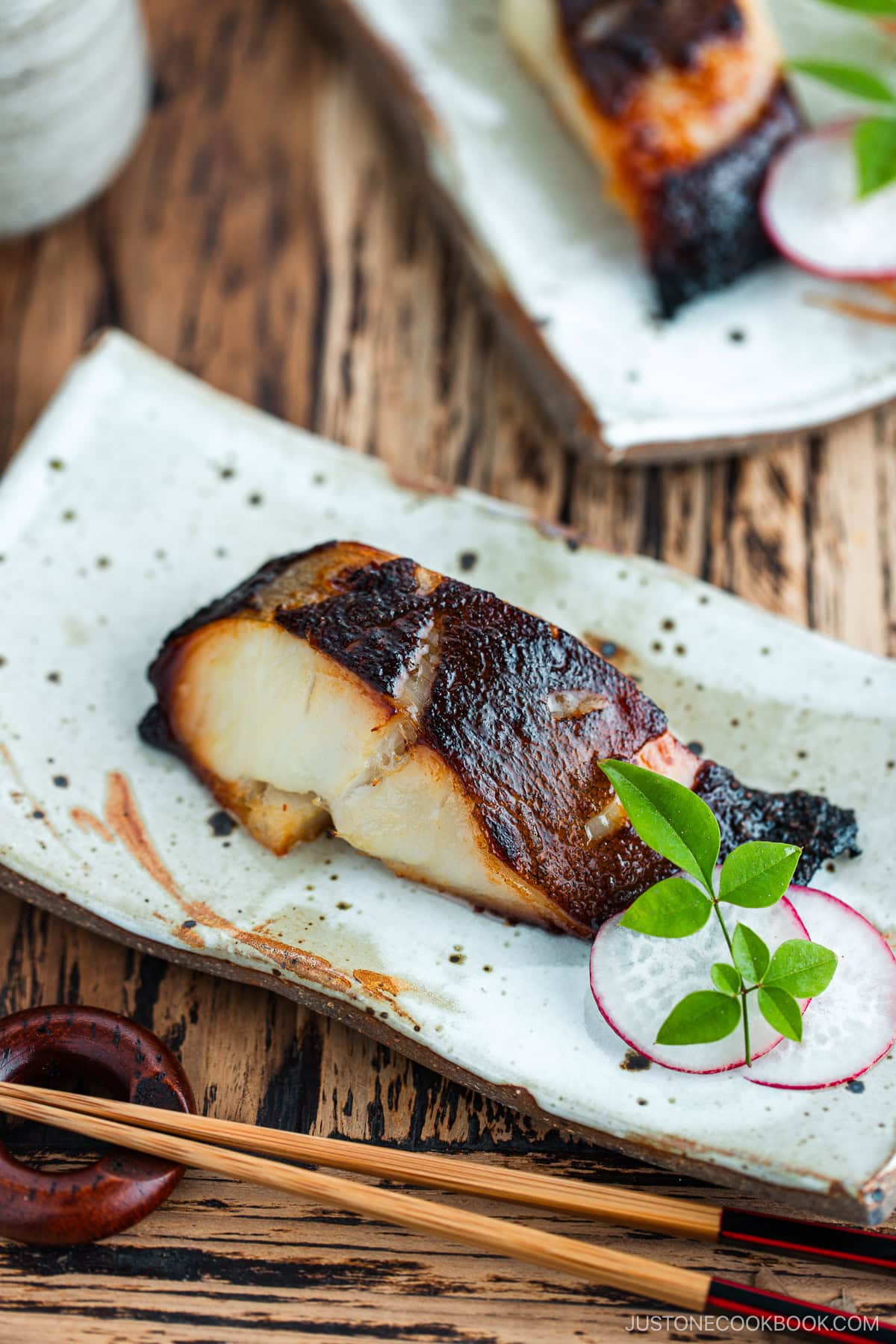
Miso Cod is world-famous as a Japanese seafood delicacy, but did you know that you can easily make it at home? The marinated black cod is so incredibly tender, sweet, and savory that my children could each finish one fillet when they were young! Today, I’ll teach you the simple steps so you can make this recipe for your friends and family, too.
Looking for more delicious fish recipes? Try my Miso Salmon, Grilled Mackerel, and Teriyaki Salmon next!
What is Miso Cod?
Black Cod with Miso (or simply Miso Cod 銀だらの西京焼き) is a beloved and classic dish served at many formal Japanese restaurants. It became world-famous more recently thanks to the acclaimed fine Japanese restaurant chain Nobu.
The specific preparation for this dish requires marination with a sweet white miso that originates from the Kyoto (formerly Saikyo) area. The marinade is called Saikyozuke (西京漬け) and includes just three ingredients: Saikyo miso (西京味噌), mirin, and sake. Once the fish is grilled, it’s called Saikyoyaki (西京焼き).
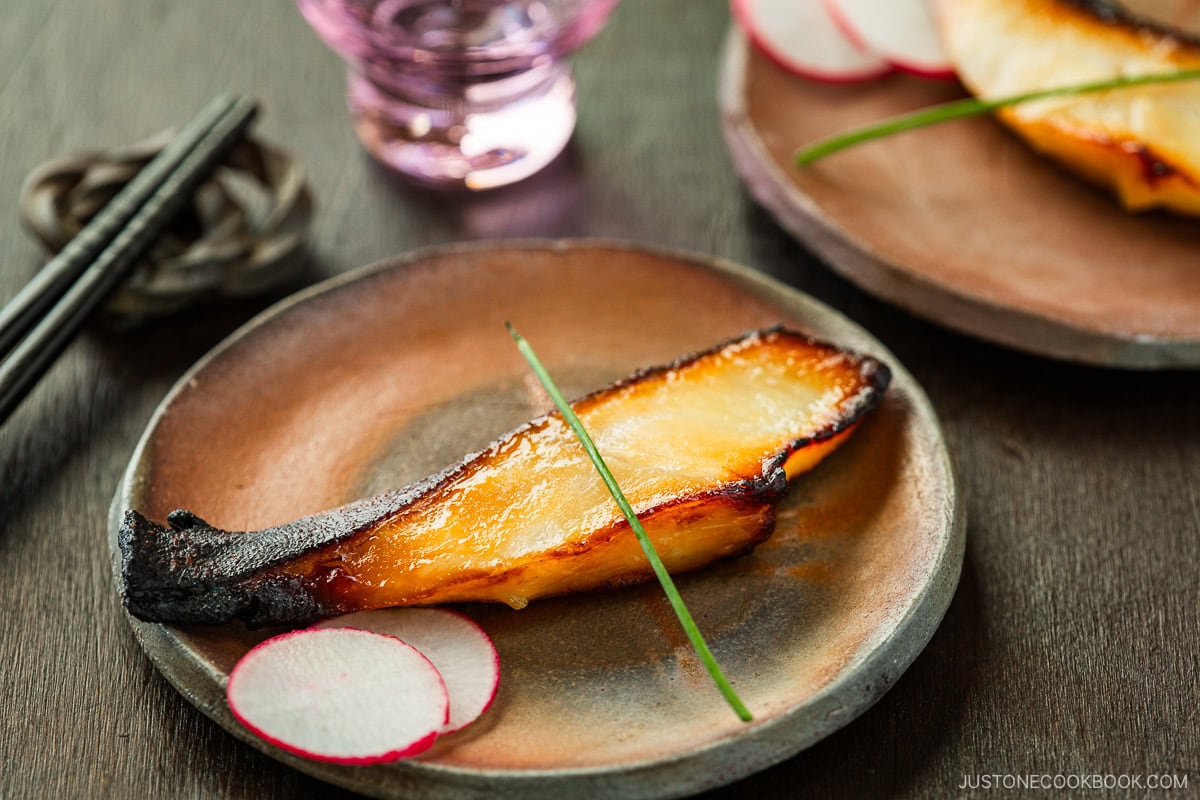
Why I Love This Recipe
- It requires only a few simple ingredients. The traditional marinade uses only 3 ingredients! I’ll show you how to substitute regular white miso if you can’t find Saikyo miso.
- Super easy prep for an elegant dish. With only 10 minutes of active prep time, you can sit back and relax while the fish marinates for 2 days. Then cook it for 20 minutes and serve. All in all, a fuss-free recipe!
- Prep-friendly! After marination, you can individually wrap the uncooked fish and store it in a freezer bag for up to 2–3 weeks. When ready to cook, just defrost it in the fridge. I love pre-marinating this fish during the busy holiday season.
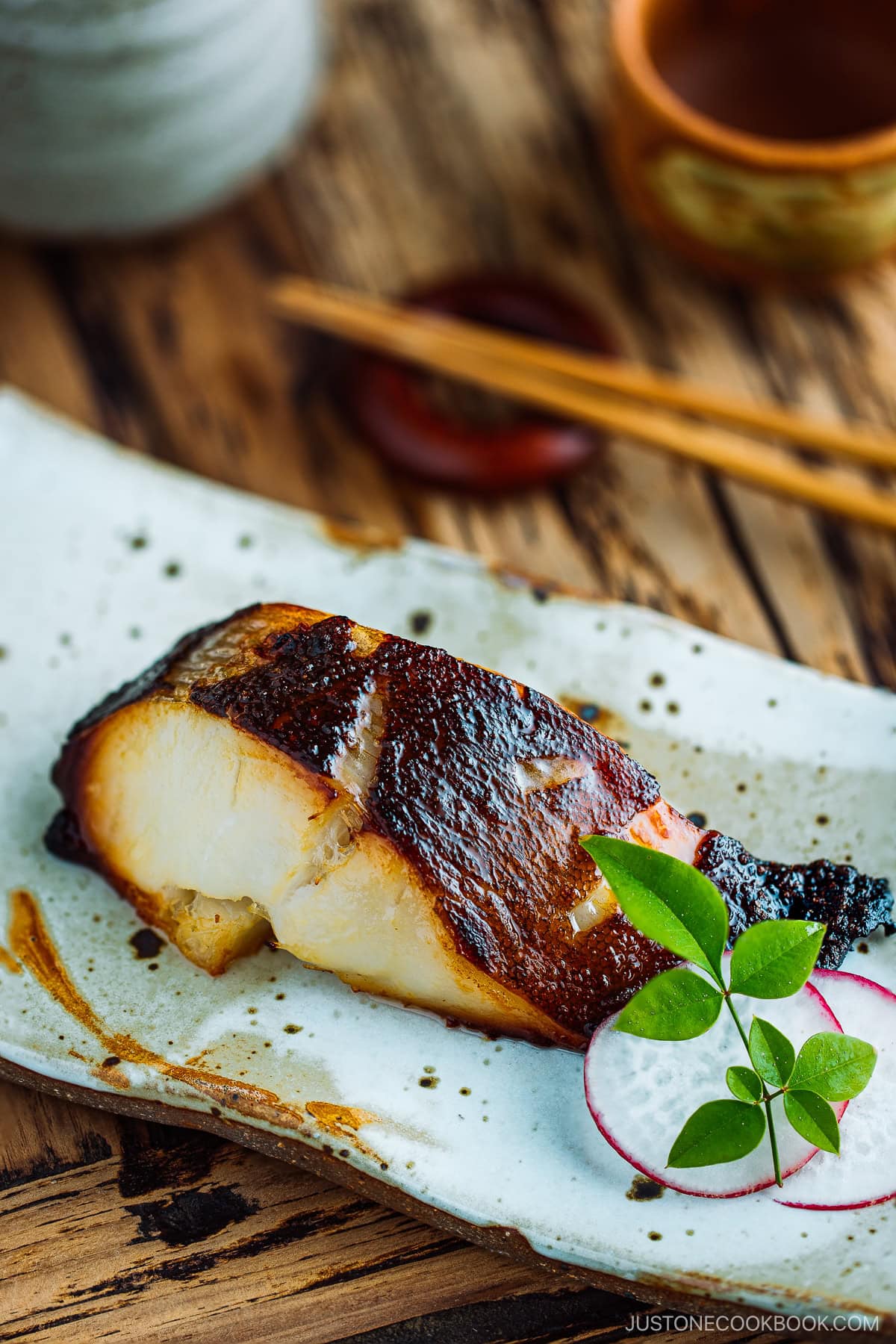
Ingredients for Miso Cod
- Skin-on sablefish fillets (gindara 銀ダラ; commonly referred to as black cod)
- Salt
- Sake – to clean the fish and remove its odor
- Marinade:
Find the printable recipe with measurements below.
Substitutions
- Saikyo miso – You can use regular white miso if you can’t find Saikyo miso. Simply add 1 Tbsp sugar for every 6 Tbsp white miso.
- Sablefish (black cod) – I buy fresh black cod from my local Japanese supermarket. You can also find sustainably caught Alaskan black cod from online seafood companies in the US. If you can’t get sablefish, I recommend using sea bass and salmon.
- Sake and mirin – For this recipe, do not replace the sake and mirin with water. If you use water instead, it can spoil during the lengthy marination and ruin the fish.
How To Make Miso Cod
Preparation
Step 1 – Salt the fish. Sprinkle kosher salt over the sablefish fillets and set it aside for 30 minutes to draw out excess moisture and reduce the fish‘s odor.
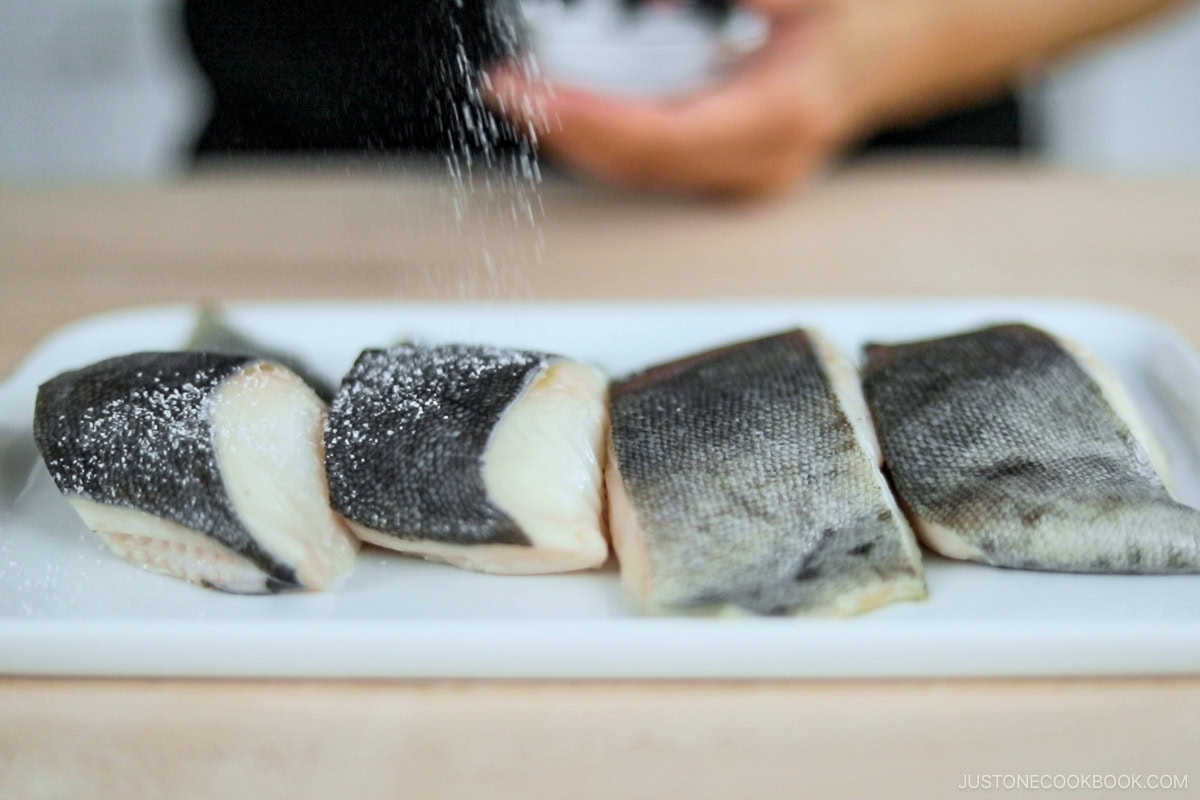
Step 2 – Make the marinade. Meanwhile, mix the Saikyo miso, sake, and mirin for the marinade. Mix to dissolve the miso completely and pour the marinade into a container.
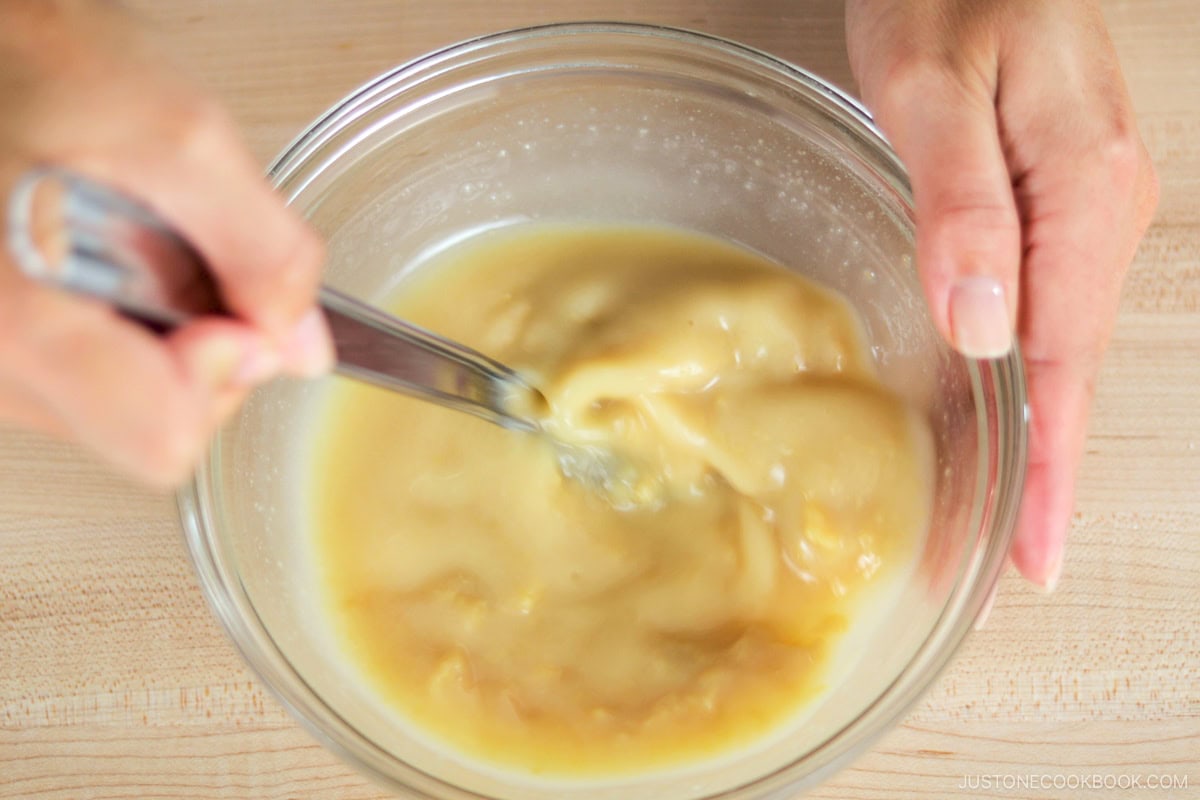
Step 3 – Marinate the fish. Pour sake over the fish to rinse off the salt and pat dry with a paper towel. Place the fish in the container and coat both sides with the marinade. Cover and marinate in the refrigerator for 2–3 days.
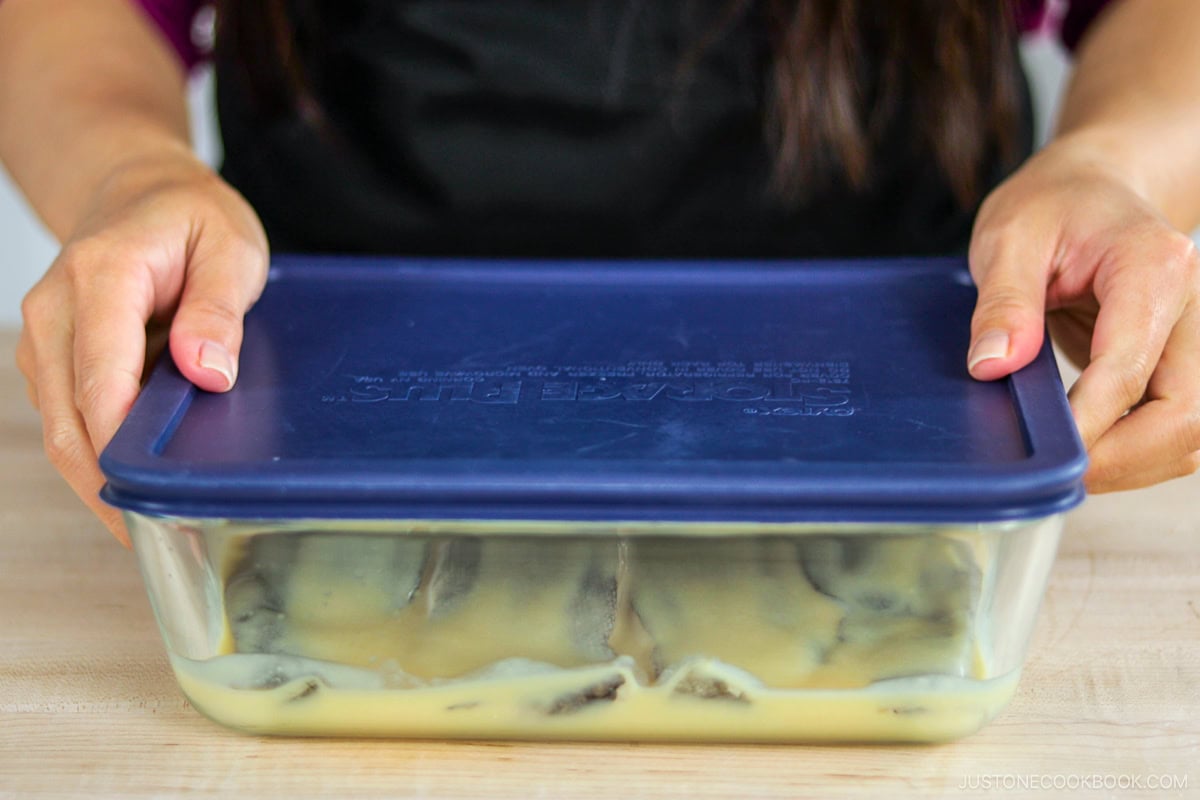
Cooking
Step 4 – Wipe off the marinade completely. With your fingers, remove all the marinade from the fish. Place the fish skin side up on a baking sheet lined with parchment paper or a silicone mat.
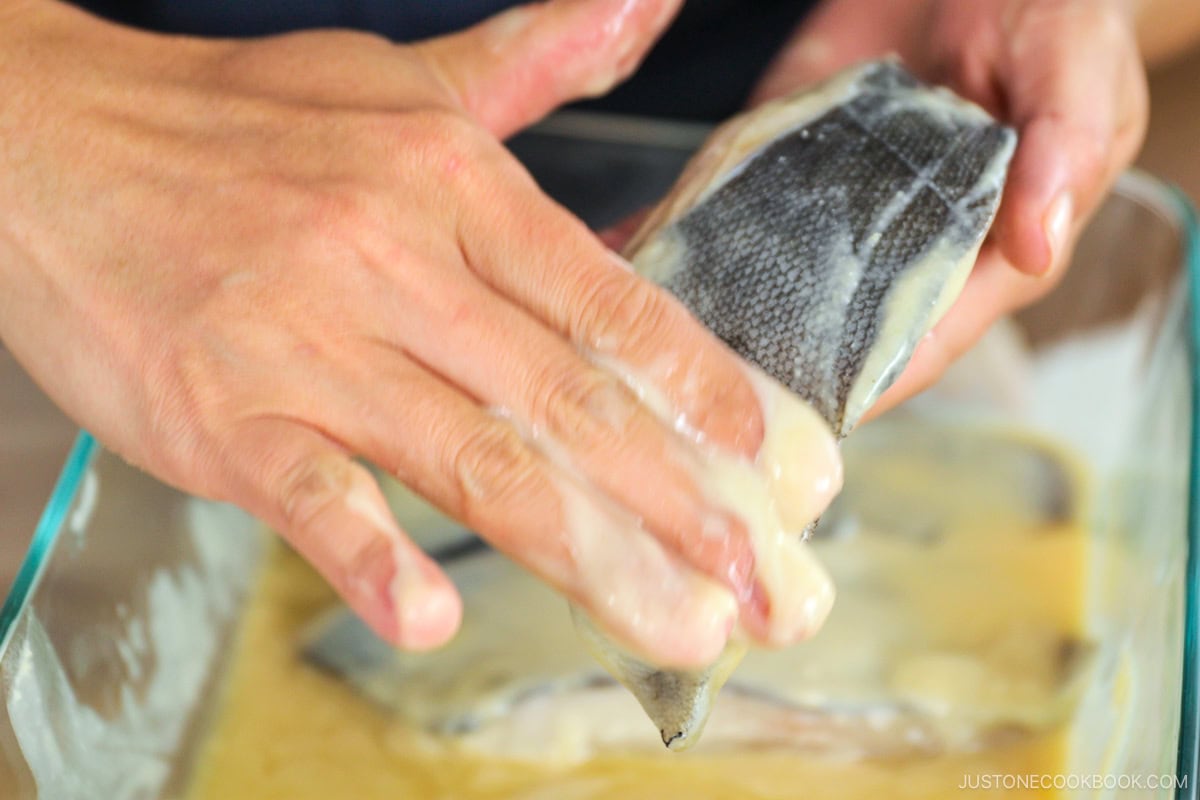
Step 5 – Bake the fish. Preheat the oven to 400°F (200ºC) and bake until the surface is blistered and a bit charred and browned, about 20 minutes. You do not need to flip the fish.
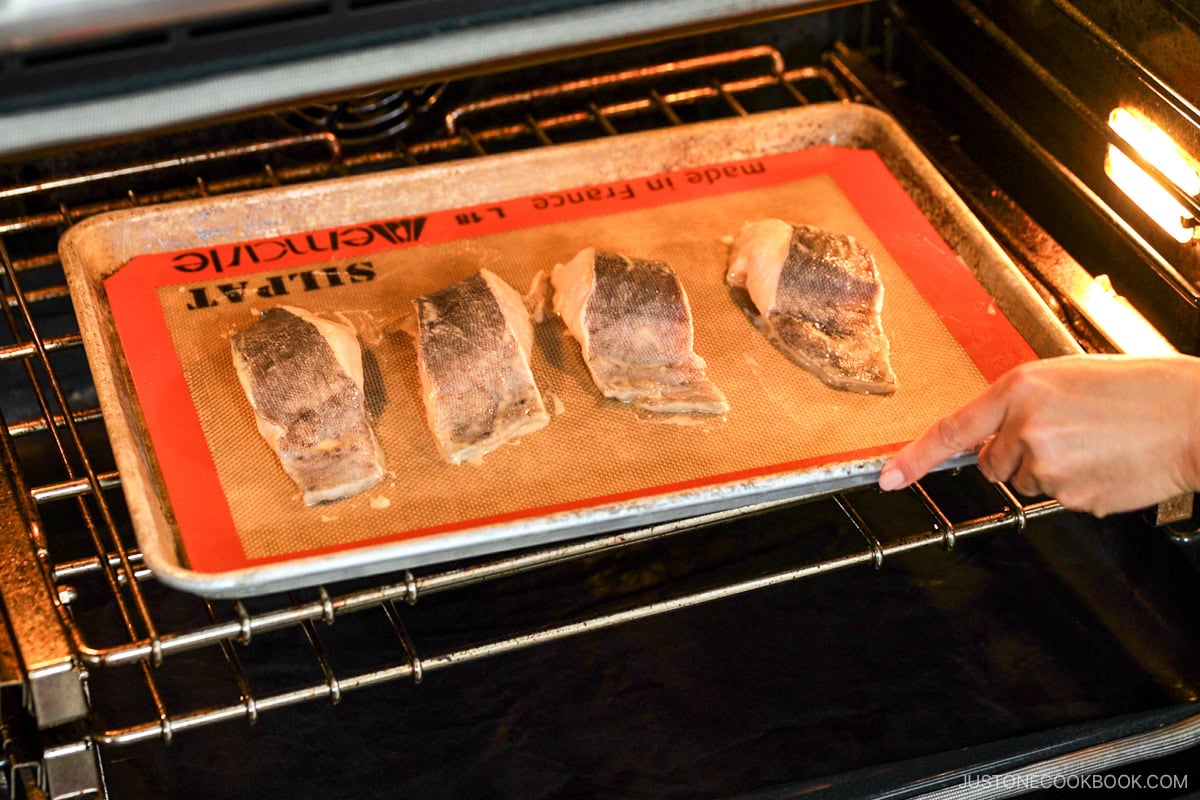
Step 6 – Serve. Carefully remove the fish with a spatula and discard any burnt miso from the fish. Serve immediately on individual plates. We always eat this dish with rice.
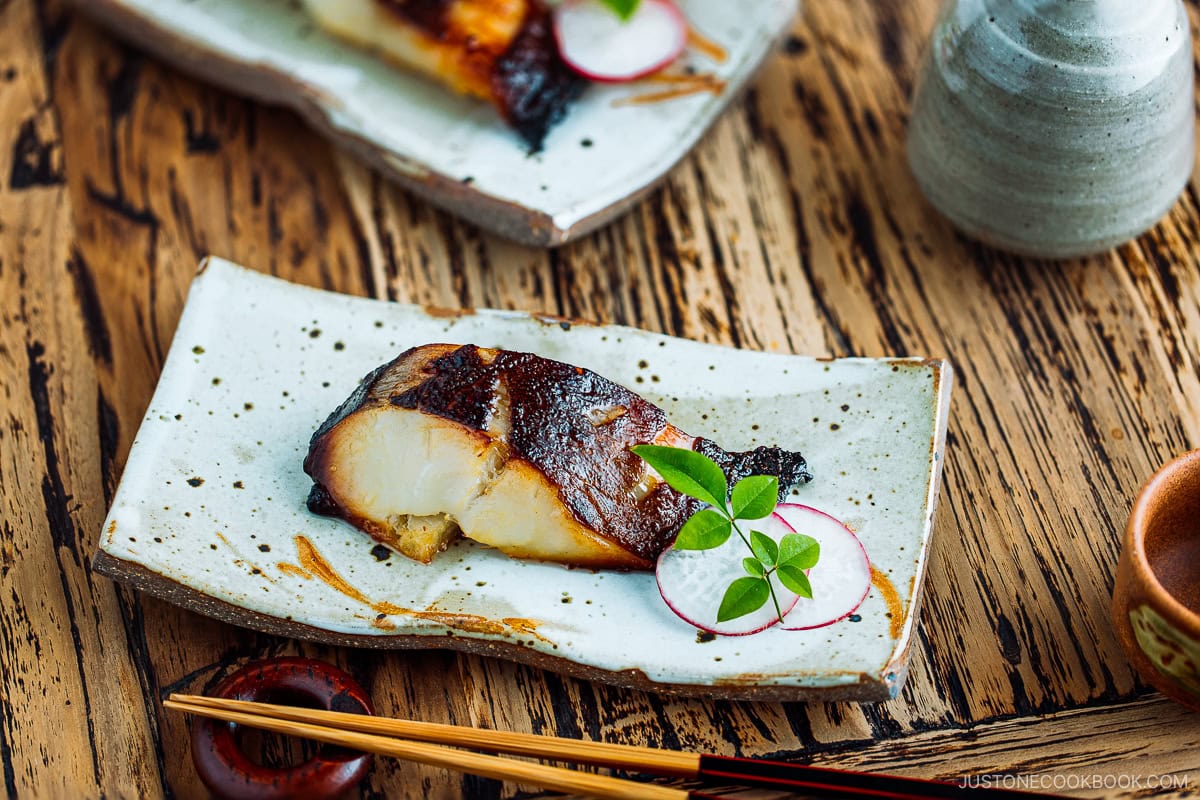
Nami’s Recipe Tips
- Use Saikyo miso for the best flavor – This Kyoto-style white miso has a wonderfully sweet, mild flavor. Along with the mirin, it makes a sharp and sweet marinade that works wonderfully to cut the fish’s richness. You can purchase it on Amazon or at your local Japanese/Asian grocery stores.
- Marinate for at least 2 days. To develop a succulent texture in the fish, I marinate it for at least 2–3 days until the sweet and salty flavor gets completely absorbed. The fillets are sometimes marinated for up to 4–5 days in Japan, but it can get quite salty and dry, so it’s usually best as an accompaniment to plain steamed rice.
- Bake it to avoid burning. Although I often broil different types of fish, I recommend baking this miso cod especially if you have never tried the broiling method before. Miso burns really easily; while you can’t avoid burning miso completely, you can minimize it by baking this fish.
- Wipe off the marinade completely. With your fingers, do your best to remove as much of the marinade from the fish as possible. Do not leave any excess marinade on the fish; otherwise, it will burn easily while baking.
Variations and Customizations
- Try it with sea bass or salmon. Black cod (sablefish) is known for its silky and tender rich texture and flavor, and is the preferred fish choice. If you can’t find it, sea bass and salmon also work well with this miso marinade. I alternate these three fish in my Saikyozuke and my family enjoys them equally. I don’t recommend fatty fish like tuna or mackerel due to the strong taste.
- Use other types of miso. You can try this recipe using another type of miso besides Saikyo miso or regular white miso. Since other miso types are saltier than white miso, please adjust the flavor by adding more mirin or/and sugar. You should also reduce the marination time to several hours or overnight.
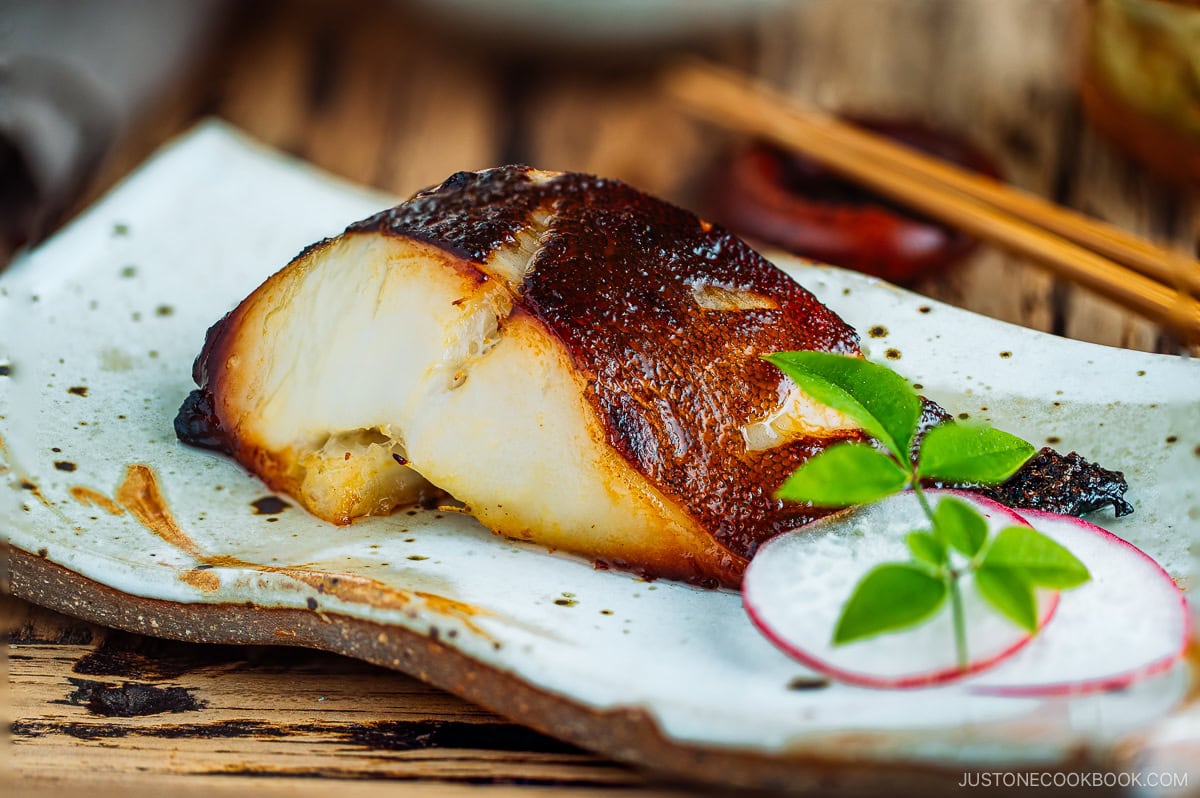
What to Serve with Miso Cod
Miso cod makes an impressive main dish as part of a classic Japanese ichiju sansai dinner. Prep it ahead, bake in the oven, and dinner is ready. I would serve it with steamed rice, a side of greens, and a simple soup. Here are some recipes that pair well with this beautiful dish:
Storage Tips
To store: You can keep the cooked leftovers in an airtight container and store it in the refrigerator for 3 days and in the freezer for up to a month.
To freeze uncooked: If you want to pre-marinate your fish to cook later, wipe off the marinade completely and individually wrap the fish with plastic wrap. Store it in a freezer bag for up to 2–3 weeks. Defrost in the refrigerator before cooking.
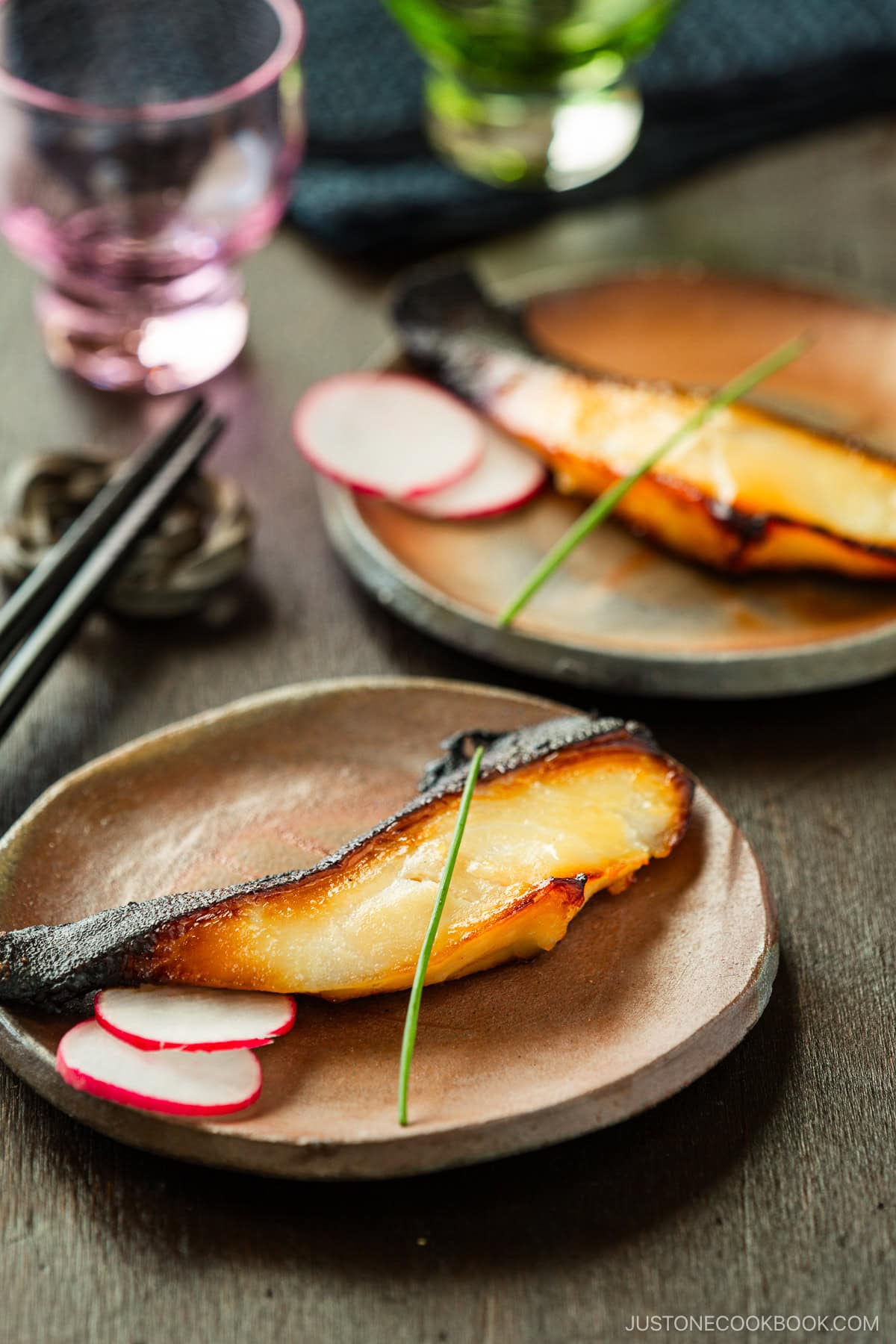
Frequently Asked Questions
We use sake to clean the fish and remove the odor. You can’t replace it with water, even though sometimes water is used as a replacement in other recipes. Since the marination time is long for this dish, the water can go bad and ruin the marinade and fish.
For this recipe, please do not use water. If you want to omit the mirin, use sugar only. For 1 Tbsp mirin, use 1 tsp sugar instead.
More Miso-Flavored Fish Recipes
If you love this Miso Cod recipe, you’re in for a treat with these other irresistible miso-flavored fish recipes.
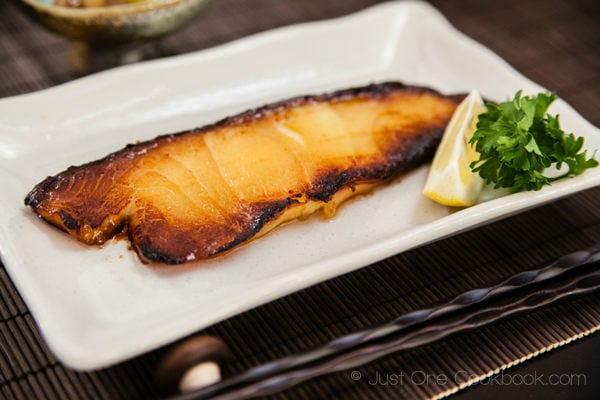
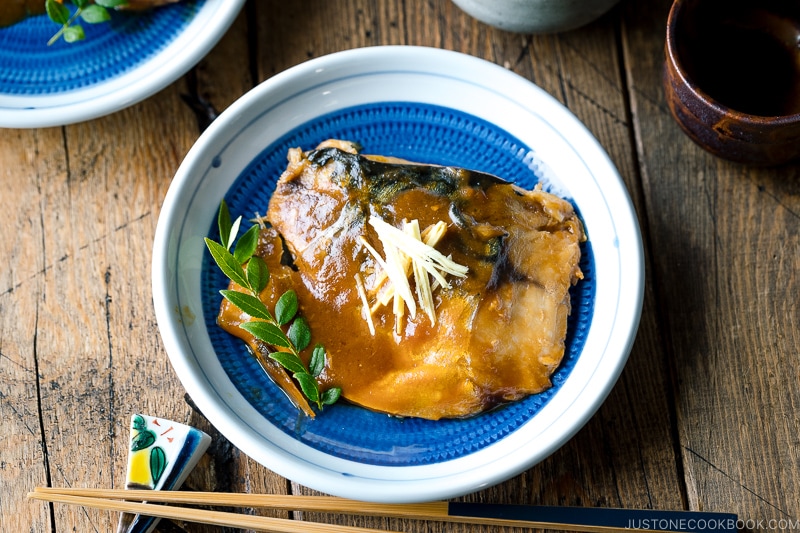
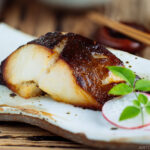
For the Miso Marinade with Saikyo Miso (Traditional)
For the Miso Marinade with Regular White Miso (Optional)
Prevent your screen from going dark
-
Before You Start: Select the freshest fish possible, as you will be marinating this fish for a few days. Please note that this recipe requires a marination time of 2–3 days. If you use skinless fish, marinate it for a shorter period of time. You can also use salmon and sea bass in this recipe.
-
Gather all the ingredients.
To Marinate the Fish (2–3 days before serving)
-
Sprinkle 2 tsp Diamond Crystal kosher salt over 4 fillets sablefish (gindara) and set it aside for 30 minutes. The salt will draw out excess moisture and reduce the fish‘s odor.
-
Meanwhile, make the marinade. In a bowl, add 6 Tbsp Saikyo miso (Kyoto-style white miso), 3 Tbsp mirin, and 3 Tbsp sake for the traditional recipe. (Optional: If you are using 6 Tbsp white miso, add 1 Tbsp sugar.) Tip: While in some recipes we can replace sake with water, it‘s not a suitable substitute in this recipe due to the longer marination time required.
-
Mix it all together and pour the marinade into a flat-bottomed airtight container.
-
Pour 2 Tbsp sake over the fish to rinse off the salt. Gently pat dry with a paper towel to remove the moisture. Do not wash the fish under running water.
-
Place the fish in the container and coat both sides with the marinade.
-
Slather the fillets with the marinade. Cover the container and keep it in the refrigerator for up to 2–3 days for the traditional method. Tip: If you are not using Saikyo miso or regular white miso, you can reduce the marination time to several hours or overnight. Since other miso types are saltier than white miso, please adjust the flavor by adding more mirin or/and sugar.
To Remove the Marinade from the Fish
-
With your fingers, wipe off the marinade from fish completely. Do not leave any excess marinade on the fish; otherwise, it will burn easily. At this point, you can individually wrap the fish with plastic wrap and store it in a freezer bag for up to 2–3 weeks. Defrost in the refrigerator before cooking.
To Bake (Recommended)
-
Preheat the oven to 400°F (200ºC) with a rack placed in the center of the oven. For a convection oven, reduce the cooking temperature by 25ºF (15ºC). Place the fish skin side up on a baking sheet lined with parchment paper or a silicone mat. Bake the fish until the surface is blistered and browned a bit, about 20 minutes. You do not need to flip the fish. Please remember the cooking time varies depending on the thickness of the fish.
To Broil (Optional)
-
Preheat the broiler* with a rack placed about 8 inches (20 cm) away from the top heating element (in the center of the oven) for 5 minutes. Tip: When broiling, you don‘t control the temperature in the oven; instead, you control the distance between the broiler and the surface of the food. It‘s similar to using hotter and cooler zones on your grill. *There are usually three broiler settings: Low (450ºF/232ºC), Medium (500ºF/260ºC), and High (550ºF/288ºC). I usually use the Medium (6 inches away) or High (8 inches away) setting.
-
Place the fish skin side up on the foil-lined baking sheet and broil on High (550ºF/288ºC) for 8–10 minutes until the surface is blistered and browned a bit. Please remember the cooking time varies depending on the thickness of the fish and the distance between the broiler and the food. You do not need to flip the fish.
- Sake: Sake is used to clean and remove the odor of the fish. You can’t replace it with water even though sometimes water is used as a replacement in some recipes. We will marinate the fish for a longer time, and water can go bad and ruin the marinade and fish.
- Mirin: Typically, mirin can be replaced with water and sugar, but for this recipe, please do not use water. If you want to omit the mirin, use sugar only. For 1 Tbsp mirin, use 1 tsp sugar.
Calories: 136 kcal · Carbohydrates: 2 g · Protein: 27 g · Fat: 1 g · Saturated Fat: 1 g · Polyunsaturated Fat: 1 g · Monounsaturated Fat: 1 g · Trans Fat: 1 g · Cholesterol: 80 mg · Sodium: 705 mg · Potassium: 411 mg · Fiber: 1 g · Sugar: 1 g · Vitamin A: 15 IU · Calcium: 17 mg · Iron: 1 mg
Editor’s Note: The post was originally published on September 21, 2011. The video and images were added in August 2018. The post was republished on October 31, 2024, with more helpful content.
Discover more from reviewer4you.com
Subscribe to get the latest posts to your email.






